
Guests
- Frida BerriganPeace activist and senior program associate of the Arms and Security Initiative at the New America Foundation. Previously, she served for eight years as deputy director and senior research associate at the Arms Trade Resource Center at the World Policy Institute at the New School in New York City. Her latest article, appearing in Tom Dispatch, is called “For the Sixty-Fourth Time: No More Nuclear War.” See picture of Daniel Ellsberg holding a baby Frida Berrigan.
- Daniel Ellsbergthe country’s best known whistleblower. In 1971 he leaked the Pentagon Papers to the New York Times and the Washington Post. The 7,000-page document exposed the true story behind US decision making in the Vietnam War. He was charged with twelve felony counts, but they were dismissed in 1973 on grounds of governmental misconduct against him. He is the author of Secrets: A Memoir of Vietnam and the Pentagon Papers. He was once described by Henry Kissinger as “the world’s most dangerous man.” Over this next year he plans to release segments of his memoir in order to reveal the true history of the American nuclear era. The first part of it appeared on Truthdig and his website last week. It’s titled “Hiroshima Day: America Has Been Asleep at the Wheel for 64 Years.” He is also the subject of a new documentary opening in New York next month called The Most Dangerous Man in America: Daniel Ellsberg and the Pentagon Papers.
- Pervez HoodbhoyNuclear physicist and disarmament activist. He is chair of the Physics Department at the Quaid-i-Azam University in Islamabad.
Sixty-four years after the bombings of Hiroshima and Nagasaki, we host a roundtable discussion on the present nuclear landscape. We speak with nuclear physicist and disarmament activist Pervez Hoodbhoy, peace activist Frida Berrigan, and Daniel Ellsberg, the whistleblower who leaked the Pentagon Papers. Over the next year, Ellsberg will release regular installments of his insider’s memoir of the nuclear era, “The American Doomsday Machine.” [includes rush transcript]
Transcript
AMY GOODMAN: We’re talking about the atomic age. Sixty-four years ago this weekend, on August 6th and August 9th, 1945, the atomic bombs were dropped on Hiroshima and Nagasaki by the US military, thus launching the nuclear age. For more on this, we’re joined now by three guests.
Pervez Hoodbhoy, nuclear physicist and disarmament activist, chair of the Physics Department at the Quaid-i-Azam University in Islamabad, joining us from Washington, DC.
Here in our firehouse studio is Frida Berrigan, longtime peace activist, senior program associate of the Arms and Security Initiative at the New America Foundation. Previously, she served for eight years at the Arms Trade Resource Center at the World Policy Institute. Her latest article appears at Tom Dispatch; it’s called “For the Sixty-Fourth Time: No More Nuclear War.”
And joining us via Democracy Now! video stream from California, Daniel Ellsberg, the whistleblower who leaked the Pentagon Papers that exposed the true story behind the US decision making in the Vietnam War. Over the next year, he plans to release segments of his memoir in order to reveal the true history of the American nuclear era. The first part appears at Truthdig and his website last week, called “Hiroshima Day: America Has Been Asleep at the Wheel for 64 Years.”
Daniel Berrigan [sic], let’s begin with you. Why focus on nuclear issues, on this memoir that you’re releasing as an internet book over the next year?
Daniel Ellsberg, sorry. We have Frida here, so I can’t stop thinking about her uncle.
Daniel Ellsberg, why focus on the nuclear age? You’re well known for releasing the Pentagon Papers about the history of Vietnam.
DANIEL ELLSBERG: I worked on — I worked on — I worked on [inaudible] —-
AMY GOODMAN: Daniel, we’re going to come back to you in a minute, because we’re going to correct the sound. But let’s turn to Frida Berrigan and your piece that is now out and your work on nuclear issues. Where do we stand today?
FRIDA BERRIGAN: Well, we stand at a precipice. We stand at this very interesting and dangerous place. We heard at the top of this story about Obama’s promise to the world, this commitment to seek peace and security through a world free of nuclear weapons. And that’s a very serious commitment. And steps have been made by his administration to move us in that direction, but they’re small steps, and they happen in the context of essentially ignorance on the part of the American people about nuclear issues, about nuclear dangers. And so, it’s sort of happening at this elite level, where Henry Kissinger and Sam Nunn and William Perry are interested in nuclear weapons, but the American people, as a whole, are distracted and basically have no awareness of what happened sixty-four years ago and what continues to threaten the world: these 27,000 nuclear weapons that are in the possession of the nine nuclear powers, the nuclear weapons that the United States has, the $6 billion that we spend on an annual basis on nuclear weapons research and development. All of these things are sort of happening outside of the consciousness of the American people, which is why it’s so important to remember Hiroshima, to remember Nagasaki, and to really push the administration to follow through on these commitments, because nuclear weapons are not going to disarm themselves.
ANJALI KAMAT: Frida Berrigan, in your article on Tom Dispatch, you talk about how the US is pursuing a “lead and hedge” policy. Can you explain what you mean by that?
FRIDA BERRIGAN: Sure. Well, within this context of a promise to disarm, the United States is very invested in continuing to be predominant and to continue to hold on to the ability to destroy the world many times over. And so, as we cut -— and there are cuts that are being negotiated with the Russians — we — it’s sort of this one step forward, two steps back dynamic where we’ll cut up into a certain point, but — we’ll lead in that way, but we’ll maintain this hedge.
So when the Bush administration negotiated cuts in 2001, we really wanted to see those weapons dismantled, and yet they were just taken offline. They could be reconnected. You know, it would be very straightforward to reconnect them. Those weapons were not destroyed; they were just taken offline.
So now, as the Obama administration is making this commitment, there really needs to be a lot of attention paid to what happens to those weapons once they’re taken offline. Are they just sort of on a shelf, that we can put them back into rotation right away? Or are they destroyed? Are they dismantled? And so, that’s a critical piece of the puzzle at this point.
AMY GOODMAN: Frida, this — the nuclear age has been the context of your life, perhaps more than many people. Talk a little bit about your family’s history. I was calling Dan Ellsberg “Dan Berrigan,” your uncle. But talk about your family.
FRIDA BERRIGAN: Sure. Well, I really feel as though I was born under a mushroom cloud, in a sense. We were so aware as little children of the dangers of nuclear weapons. I write in the Tom Dispatch piece that we would watch movies about Hiroshima and Nagasaki on the wall of our living room.
And we learned about Sadako, a little girl in Hiroshima who was found to be sick with atomic bomb sickness as a nine-year-old who died of leukemia and who, on her sickbed, folded more than 600 paper cranes, trying to fulfill this belief that if you fold a thousand paper cranes, your wish is granted. And, of course, her wish was for her own health and for wellness for herself, but also for peace in the world and for Hiroshima never again.
And so, we learned all about that as children, as our parents and our community there at Jonah House took the bomb very personally and committed to its dismantlement through acts of nonviolent civil disobedience over the years. And so, all of that education was very important for us, so that we could understand what peace activists were doing to try and make the world safe.
AMY GOODMAN: I wanted to go back to 2002. I was in Washington, DC. It was a peace rally just before the Iraq war. Your father, Philip Berrigan, was speaking at the rally, lifelong peace activist. He spent more than eleven years in prison for his antiwar, anti-nuclear activism. He spoke here in Washington.
PHILIP BERRIGAN: We are number one in war, and war is our number one business. We’re number one in poisoning the planet with radioactive garbage. And I recently received a report from Afghanistan: we have poisoned that land with 3,000 tons of depleted uranium, these huge — these huge bombs we have manufactured, earth-penetrating and rock-penetrating, and we have left it as a legacy to that unfortunate land. We’re number one in paying for war. And at last count that I came across, it’s something like $20 trillion. We’re number one in killing people — one-half million annually, resulting from our leadership of the nuclear club. One-half million annually, the world’s people, and increasingly, as the cancer epidemic hits this country, our own people.
AMY GOODMAN: Philip Berrigan, speaking at a peace rally in 2002. He died about half a year later at his home, at Jonah House in Baltimore, of cancer. Frida, your father, your uncle, Daniel and Philip Berrigan, I don’t know how many times they were arrested for civil disobedience, starting with the burning of the draft cards in Maryland, burning with napalm draft cards in Vietnam. You, too, have been arrested many times. Talk about that kind of activism that you all engage in.
FRIDA BERRIGAN: Sure. Well, at the end of that speech there in April of 2002, my dad says, “Don’t get tired. Don’t get tired.” And I think that’s really an important message at this moment, to not get tired, not get tired in the context of all of these nuclear weapons, not get tired in the context of the war in Afghanistan, the ongoing war in Iraq. Don’t get tired in the midst of a struggling economy. And so, activism, being out in the streets, being with other people, is part of not getting tired. And it is what enlivens and enriches and motivates us to continue going, even when things are — things are bleak.
ANJALI KAMAT: I want to turn to Daniel Ellsberg, the country’s best-known whistleblower. Your new project is to reveal this memoir of the nuclear age. You want to reveal the secrets of the nuclear era. Can you talk about this project?
DANIEL ELLSBERG: Yes. In 1961, after seven years at the RAND Corporation of consulting with the Defense Department on nuclear war plans and nuclear command and control and nuclear crises — I participated in the Cuban Missile Crisis in ’62 — in ’61, I drafted for Secretary of Defense McNamara the general war plans guidance to the Joint Chiefs of Staff for the operational plans for general nuclear war. And I reviewed those in ensuing years. And all that was before I worked on Vietnam.
In the course of that work and in the thirty more years’ research that I’ve done since then, I’ve become aware that we’ve come much, much closer to nuclear war than almost any American realizes, inside or outside the government, not only in the Cuban Missile Crisis, but in a couple of dozen other cases, some — several of which came quite close to actual nuclear war.
And we’re preparing for it still. There is still the possibility of war plan options that would destroy cities, whether targeted directly on them or not, and possibly cause nuclear winter, ending life on earth. Both Russia and the US have built the capability to destroy complex life on earth, the civilization of the world, and could do that within hours — in effect, two doomsday machines, both of which are prone to error, to false alarms, to accidents, and to deliberate triggering. So this world is in much more danger from nuclear weapons, the ones that we possess already, than I think almost anyone realizes, even people in the anti-nuclear movement.
And by the way, I’m so happy to be on a program with Frida Berrigan. I don’t know if you still have the picture there I showed you of my encounter with her when she was two years old, but I did see her father when we got arrested together, one of the last times I saw him, in Bitburg, Germany, protesting the installation of cruise missiles at Bitburg and at Mutlangen, where there were Pershing and cruise missiles. We both got arrested by the Germans at that point. So I’m very happy to see that she hasn’t gotten tired. And although I don’t think I could hold her up to the ceiling again anymore, I’m very glad to be working arm-in-arm with her on this problem.
ANJALI KAMAT: Daniel Ellsberg, talk about how the weapons have changed since the time of Hiroshima sixty-four years ago. Both you and Frida Berrigan talk about the completely different and much more enormous nature of the weapons that we have today. In your piece, you say, “Our popular image of nuclear war — from the familiar pictures of the devastation of Nagasaki and Hiroshima — is grotesquely misleading. Those pictures show us only what happens to humans and buildings when they are hit by what is now just the detonating cap for a modern nuclear weapon.”
DANIEL ELLSBERG: That’s correct. The scientists in the spring of 1945, 160 of them in the Manhattan Project, signed a petition to the President, which never did get to President Truman — it was bottled up before it could get to him — asking him to seriously consider not dropping the bomb on Japan — in fact, the first version of that petition just said, “Don’t do it” — and not mainly or only because of the killing of civilians, which were sure to result there, but because of the long-run consequences of that use of the bomb, which did then occur.
What they saw was that if we use that bomb at that point in the war, where it was clearly not needed to bring a surrender — that’s a very controversial issue, which I won’t get into here — but use of it, even if it would save American lives and shorten the war, would be sure to cause a nuclear arms race with the Russians, initially, the Soviets, and eventually lead to a weapon much, much, much larger: the H-bomb, the thermonuclear weapon, whose explosive power can be — and the early ones were — a thousand times more powerful than the Nagasaki bomb.
Every H-bomb — and we now have over 2,000 operational strategic H-bombs right now; the Russians, likewise — and as Frida has said, some 10,000 each on the shelf are in various stages, not dismantled, 20,000 or so H-bombs, close to that, each one of them has a Nagasaki-type bomb for its trigger, for its detonator. It requires that. We’re seeing, in the pictures of Nagasaki, what happens if you use, as you said, the detonator or the percussion cap of a modern nuclear weapon.
That arms race was not avoided. We did use a bomb. The scientists were correct. The H-bomb did come along and now threatens humanity in a way that I think very few people can really comprehend.
AMY GOODMAN: Daniel Ellsberg, we’re also joined in Washington by Pervez Hoodbhoy, nuclear physicist, disarmament activist. He is usually teaching in Islamabad in Pakistan, but is in the nation’s capital today.
I wanted to ask you, Secretary of State Clinton is now going to the Democratic Republic of Congo, but before her Africa trip, she made a major trip to India, where she was working on, among other things, selling India more nuclear technology. Can you talk about what’s happening in your neck of the woods, in Pakistan and India, and where the nuclear arms race stands, Professor Hoodbhoy?
PERVEZ HOODBHOY: I certainly will, but let me first say that I am so privileged to be on the same program as Daniel Ellsberg and with one of the Berrigans, who have — who I’ve admired all my life.
As far as Hillary Clinton’s visit goes, I think that selling arms to India and fueling the arms race on the subcontinent is just a very bad thing to do. India is now embarking on a major rearmament. It has just commissioned a nuclear submarine, which is out for sea trials. That submarine is going to be equipped with cruise missiles that can carry nuclear warheads. It’s also negotiating a nuclear attack submarine. It’s expanding its nuclear arsenal. And with the US-India nuclear deal, there’s going to be more fuel in the fire for expanding the arms race, which already is now a reality and has been a reality for the last ten years, after both India and Pakistan tested.
Now, as someone who has opposed Pakistan’s nuclear weapons from its very inception, I feel that we in Pakistan, the few of us in Pakistan who continue to say that we should not have nuclear weapons, are being placed at an increasing disadvantage as we see that the Indian government across the border is engaged in a massive nuclearization. And so, it’s more warheads, and it’s better delivery vehicles. It’s nuclear submarines. It’s aircraft, radars, etc.
Now, the Indian defense budget has gone up this year by 40 percent. It now stands at $28 billion, and Pakistan’s is about roughly $8 billion or so. And next year, the Indian defense budget is going to go up to $40 billion. And that’s, of course, going to force Pakistan to increase its nuclear arsenal and rely upon nukes.
Now, it’s not necessary. It simply is extremely dangerous. It’s something that is forcing Pakistan to be dragged along in the race. And people like us, who protest nuclear weapons, are becoming increasingly marginalized.
ANJALI KAMAT: And Professor Hoodbhoy, can you talk a little bit about what this does to the NPT, to the Non-Proliferation Treaty? This sort of encouragement of US encouraging India, fueling the arms race, what does this mean for the future of nonproliferation and disarmament?
PERVEZ HOODBHOY: Oh, I think it has pretty much destroyed the Nuclear Non-Proliferation Treaty, which says that no nuclear assistance may be given to a country that has not signed the treaty, and indeed India has not. But furthermore, it surreptitiously made nuclear weapons. It did so using fuel from a reactor given to it from Canada, which was given for purely peaceful purposes, for electricity generation. And so, when India crashed into the nuclear club, it did so in violation of all international laws, the agreement it had with Canada.
And now, to reward those who transgress and those who violate solemn understandings, I think, is just a very bad idea. And it’s an encouragement. It says that, OK, if it’s in our national interest, if it’s in our economic interest, we in the United States will do whatever we want. And that’s not a good thing, because, look, how are you going to stop Iran? Iran is doing, or trying to do, exactly the same thing.
The NPT now is, if not dead, severely wounded. And that’s really sad, because this is something that the United States — this was an initiative of the United States. And bad as it was, discriminatory as it was, it did keep back the world from becoming even more nuclearized. And now that it’s gone, well, what’s going to replace it?
I must say, I’m very happy with President Obama’s initiative; I think it’s a very good thing. If the US now signs on to the CTBT — it had, as you know, reject — the Senate had rejected ratification of the CT —
AMY GOODMAN: The Comprehensive Test Ban Treaty.
PERVEZ HOODBHOY: Right, right, the Comprehensive Test Ban Treaty. But if the United States now shows its seriousness about getting rid of nuclear weapons or seriously downscaling and, in particular, agrees to the verifiable Fissile Materials Cutoff Treaty, so that the production of highly enriched uranium or weapons-grade plutonium is stopped, well, I think that there’s practically no way that Pakistan or India will not follow. They can be then made to follow. And that, to me, is really the basic hope for getting to a nuclear weapons-free world.
AMY GOODMAN: Well, Pervez Hoodbhoy, we’re going to leave it there. We thank you very much for joining us, nuclear physicist, disarmament activist, a Pakistani professor in Islamabad. We also want to thank Frida Berrigan, peace activist, senior program associate of the Arms and Security Initiative at the New America Foundation. Her piece at Tom Dispatch is called “For the Sixty-Fourth Time: No More Nuclear War.” And we want to thank Dan Ellsberg for joining us, the country’s best-known whistleblower. He is releasing installments of his internet book through this year. The latest piece is called “Hiroshima Day: America Has Been Asleep at the Wheel for 64 Years.”
And we will show on our TV broadcast, as well as on the internet, for our radio listeners, that picture that Dan was describing, a picture of Dan Ellsberg holding a little Frida Berrigan many, many years ago. And that does it for this segment.
But as we talk about the situation of escalation in the world, we’re going to turn now to Iran after break. Stay with us.

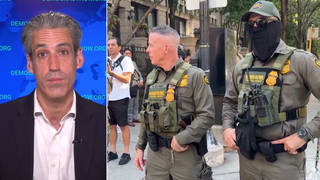
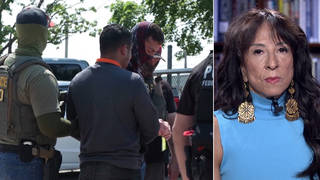
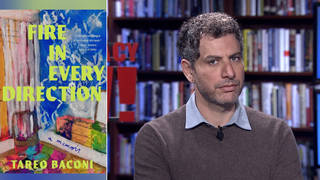
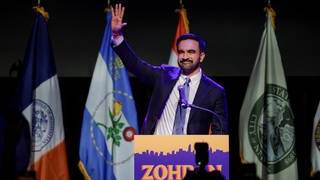





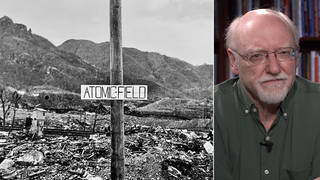
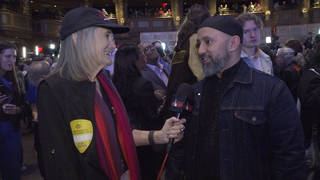
Media Options